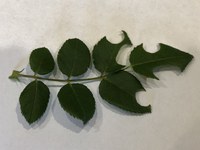Dakota Gardener: Take Time to Observe the Pollinators in Your Yard
(Click an image below to view a high-resolution image that can be downloaded)
Esther McGinnis, Horticulturist
NDSU Extension
As I was gardening last weekend, a super highway of insects buzzed around me as they flew from the front of my house to the backyard.
What caught my attention was that I kept seeing flashes of green. Intrigued, I looked closer. Each insect was carrying a tiny bit of a leaf.
To investigate, I went to the front of my house. Sure enough, the leaves on my rose bush looked like someone had taken a hole punch and punched out little disks of leaf tissue.
Did I go look for insecticide? Absolutely not! The holes in the leaves are a sign that my yard is a hospitable habitat for an important native pollinator known as the leaf cutter bee.
I then followed the bees to the backyard and saw that they were taking the leaf disks to a crack in one of my wooden planters.
Leaf cutter bees are 1/2-inch bees that are darker than our yellow honeybees. These dark gray bees cut semicircular disks from the leaves of roses, ash trees, lilac shrubs and Virginia creeper vines.
The leaf disks are used to line a cylindrical nest in which the mother bee lays up to 12 eggs. Each egg is sealed in its own leaf-lined cell and is provisioned with a mixture of pollen and nectar to nourish the larvae when they hatch.
Leaf cutter bees build nests in rotting wood but will take advantage of man-made openings such as in my wooden planter. They cannot tunnel into wood that isn’t disintegrating.
The leaf damage to the rose shrub is minor and will not harm the plant. If I had reached for an insecticide, I might have killed an important pollinator of native plants.
Across the yard, huge bumble bees were collecting pollen from the false indigo plant (Baptisia). False indigo is in the same family as beans and peas. Their flowers are unique in that the five petals enclose the stamens and pistil. It takes a hefty bee such as a bumble bee to push down the lower two petals and access the pollen and nectar.
Am I afraid that the bees in my yard are going to sting me? No! Leaf cutter bees and bumble bees are not aggressive. They won’t sting you unless you are intentionally trying to disturb them. I’ve had bumble bee nests in my garden and they never have bothered me as I work.
In all the years I have gardened, I never have been stung by a bee. However, I did experience a painful sting from a yellow jacket wasp. Wasps and hornets are generally more aggressive than bees and require more caution.
North Dakota State University Extension Master Gardener Caitlin Stegmiller has created the acronyms WASP and BEE to distinguish wasps from bees. Wasps have the following characteristics:
- Waist is defined and narrow
- Attracted to meat and soft drinks
- Shiny appearance
- Predator
In contrast, bees have the following characteristics:
- Bushy, hairy body
- Eat pollen or nectar
- Easy going and unlikely to sting unless threatened
For more information on gardening for pollinators, see the following NDSU Extension publication: https://tinyurl.com/2yr3b7pm.
For more information about gardening, contact your local NDSU Extension agent. Find the Extension office for your county at https://www.ag.ndsu.edu/extension/directory/counties.
NDSU Agriculture Communication - June 22, 2021
Source: Esther McGinnis, 701-231-7971, esther.mcginnis@ndsu.edu
Editor: Ellen Crawford, 701-231-5391, ellen.crawford@ndsu.edu




